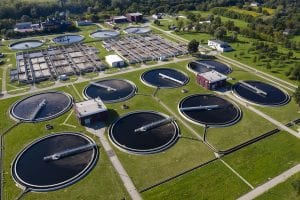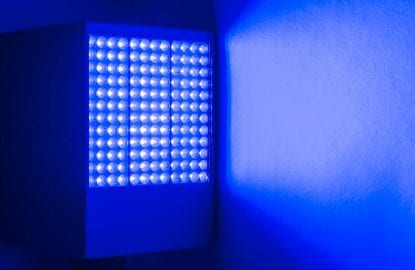What is UV-C LED technology?
A UVC light-emitting diode is a semiconductor device that emits light in the 200-280nm range when an electric current is passed through it. UV-C light is proven to reduce or eliminate E. coli, Salmonella, Listeria, and other foodborne pathogens. In addition, preliminary research utilizing UV-C LEDs to combat SARS-COV is encouraging. UV LED manufacturer Seoul Viosys and SETi’s Violeds Technology proves 99.9% sterilization of Coronavirus (COVID-19) in 30 seconds.
In UVC Disinfection applications, the radiation is absorbed by the microorganisms’ DNA destroying its structure. This inactivates the living cells. UVC radiation reliably improves hygiene and storage conditions.
Mercury lamps, Excimer lamps and pulsed Xenon were previously the only options for utilizing UVC light for disinfection, but with recent technology advancements, UVC LED technology can now offer many advantages over traditional technologies including compactness, lower cost of ownership, longer lifetimes, and a significantly reduced environmental impact.
How does UVC LED work?
UV based disinfection (often termed as Ultraviolet germicidal irradiation or UVGI) is the use of ultraviolet (UV) energy (electromagnetic radiation with a wavelength shorter than that of visible light) to kill or inactivate viral, bacterial, and fungal species. Different wavelengths of UV in the range of 200nm to 300nm are absorbed by DNA, RNA, and proteins. When UV light is incident upon the target source the incident photons are absorbed by DNA or RNA and cause the inactivation of the DNA or RNA double helix strands through the formation of molecular lesions. If enough of these lesions are created, the replication process is disrupted, and the cell cannot reproduce. Also, absorption by proteins can lead to the breakdown of organism’s cell walls causing the cell to die. For most applications, replication prevention is sufficient. The UV doses required to prevent replication are much lower than required to kill, making the cost of UV treatment to prevent infection commercially viable.
Applications for UVC – LEDs
UVC LED disinfection technology is advancing rapidly in water, surface, and air disinfection in food processing, medical and laboratory, packaging materials, and industrial applications. The three key application areas are:
- Water Disinfection
- Surface Disinfection
- Air Disinfection
1. Water Disinfection
Growing local and global environmental legislation as well as heightened interest in environmental issues has led to increased development of highly efficient water treatment and disinfection processes. Water disinfection removes, deactivates, or kills pathogenic microorganisms.
Recently, energy-efficient UVC LED technology has led to the development of novel UVC LED reactor designs for the removal of wastewater pollutants, including emerging contaminants, antibiotic-resistant bacterial genes, and pathogens. The flexibility of LEDs allows them to be designed into small domestic settings, commercial units, and most recently industrial-scale systems.

2. Surface disinfection
UVC LED Technology can ensure surfaces are reliably disinfected in seconds. UVC light is used in food production lines, for example, to disinfect materials efficiently and easily. UVC LEDs have been integrated into high-touch areas such as escalator belts and door handles to reduce the spread of infection. Surface disinfection makes the most sense when the products are prone to contamination.
3. Air disinfection
In high-traffic areas such as airports, hospitals, and theaters UVC LED technology can be used in Air disinfection. Airborne microorganisms such as viruses, bacteria, yeasts, and mold can jeopardize people’s health, contaminate raw materials, and cause food to spoil. Disinfecting air in the supply air ducts ensures efficient reduction of microorganisms for the long term.

What wavelengths are available?
Wavelengths available include 255nm, 265nm, 275nm, and 285nm. 265nm is considered the optimum wavelength for disinfection as it is the peak of the DNA absorption curve. However, disinfection and sterilization occur over a range of wavelengths, and in certain applications, alternative wavelengths should not be dismissed.
UVC LED technology enables the manufacturing of lamps to target specific and narrow wavelengths. This allows solutions to be tailored to the application need.
Advantages of UV-C LED technology
UVC LED technology offers many advantages over traditional technologies. In addition to compactness, longer lifetimes, and a lower cost of ownership, this technology offers significantly reduced environmental impact. LED technology offers energy savings for several reasons. The technology offers higher electrical efficiency, lower heat emissions, and greater control minimizing the energy required in operation. UVC LED technology offers design advantages enabling more compact and robust designs and the ability to customize UV reactors with individual wavelengths. This allows solutions to be tailored to the application need. Choosing LED technology avoids the environmental impact of toxic mercury waste and reduces the need for chemical additives to ensure adequate disinfection.
Additional FAQs
-
What is UV-C LED?
A UVC light-emitting diode (LED) works like any other LED. It is a semiconductor device that emits light when an electric current is passed through it. Light is produced when the particles that carry the current (known as electrons and holes) combine within the semiconductor material. Since light is generated within the solid semiconductor material, LEDs are described as solid-state devices. It distinguishes LEDs from other sources that use heated filaments (incandescent and tungsten halogen lamps) or gas discharge (mercury lamps). The UVC wavelength band is defined as being in the range of 200-280nm. Currently, LEDs are commercially available between 255nm to 280nm.
-
What is the difference between UV and UV-C?
Ultraviolet light (UV) is in the range of 200-395nm and is of three types: UVA, UV-B, and UVC. UV-C is the UV range of 200-280nm. Typical UVC LEDs in the market emit at 255, 265, 270, and 285nms. While UV-A is now being used in curing applications effectively, UVC LEDs are now starting to be commercialized for applications cleaning, disinfection, and sterilizing applications.
-
What is meant by UV-C?
The UVC wavelength band is defined as being in the range 200-280nm. A UVC light-emitting diode (LED) works like any other LED. It is a semiconductor device that emits light when an electric current is passed through it. Light is produced when the particles that carry the current (known as electrons and holes) combine within the semiconductor material. Since light is generated within the solid semiconductor material, LEDs are described as solid-state devices. It distinguishes LEDs from other sources that use heated filaments (incandescent and tungsten halogen lamps) or gas discharge (mercury lamps).
-
How long do UV-C LEDs last?
There are several factors that affect the lifetime of an LED including the frequency of use, the temperature of the environment that the LEDs are operating in, and the electrical current the LEDs are operated at. Furthermore, LEDs will reduce in intensity over a period. Luckily, UV-C LED lamp manufacturers provide lifetime based on hours of operation and degree of reduction in intensity. For example, an LED lamp that states a lifetime of 10,000 hours to L80 means that the lamp will operate for 10,000 hours and will reduce in intensity down to no more than 80% of its original maximum intensity in that time period.
-
What are the different types of UVC-LEDs?
Today UV-C LEDs are commercially available between 255nm and 285nm. The most popular wavelength is 265nm, the optimal wavelength for disinfection because it is the peak of the DNA absorption curve. Sub 255nm LEDs are in development but are in the research phase.



